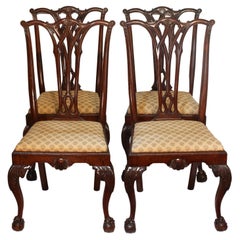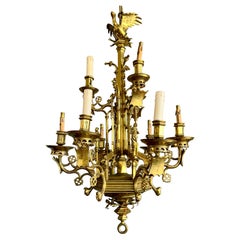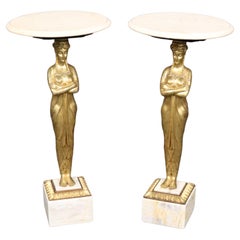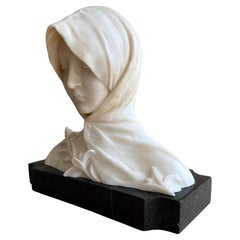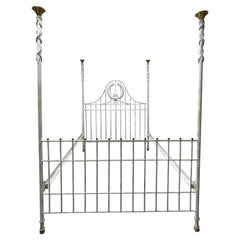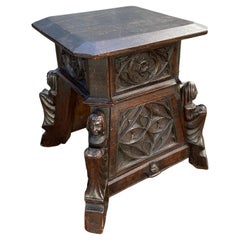Revival Furniture
to
1,615
3,355
2,864
6,143
551
72
196,860
114,806
44,094
33,045
16,210
12,149
10,892
10,837
9,955
8,920
7,329
6,611
6,520
6,381
6,213
6,110
4,933
3,753
141
2,956
3,046
623
1,100
954
459
180
42
147
97
101
161
136
161
68
54
3,059
2,769
924
913
830
4,966
1,610
1,416
736
605
6,766
6,574
6,660
267
51
24
21
21
Style: Revival
Set of 4 Colonial Revival Dining Chairs
Located in Chapel Hill, NC
Circa 1900 Set of 4 Dining Chairs, Colonial Revival, Philadelphia form. All sides; mahogany. Richly developed with Gothic influenced back splats, cabriole legs with ball & claw feet,...
Category
Early 20th Century Revival Furniture
Materials
Wood
$1,200 Sale Price / set
33% Off
Awesome Antique Bronze Gothic Revival 9 Light Chandelier with Phoenix Sculpture
Located in Lisse, NL
Handcrafted and truly impressive Neo-Gothic Church fixture that can also be used for candles.
Over the decades we have sold a number of very good antique bronze, Gothic light fixtures for both candles and electrical bulbs. However, we never offered one as high and with as many Gothic details as this hand-crafted chandelier. You will rarely come across a Gothic work of religious art that is more elaborate and with as many Gothic details as this fit-for-a-castle pendant...
Category
Late 19th Century French Antique Revival Furniture
Materials
Gold, Bronze
Pair of Tall Gilded Figural Marble Top Neoclassical French End Tables
Located in Swedesboro, NJ
This striking pair of French Neoclassical end tables embodies timeless elegance and sculptural refinement. Each table features a tall, finely cast gilded bronze female figure, draped...
Category
1940s French Vintage Revival Furniture
Materials
Composition, Marble
Italian Alabaster Bust of a Young Woman, Possibly Saint Catherine of Siena c1890
Located in Lisse, NL
Museum quality sculpture of a serene possibly Saint Catherine of Siena.
This exquisite Italian alabaster bust, carved circa 1890 and set upon a dark, polished marble base, emanates ...
Category
Late 19th Century Belgian Antique Revival Furniture
Materials
Alabaster, Marble
Vintage Neoclassical Iron Four Poster Bed Maitland Smith
Located in W Allenhurst, NJ
Wonderful Iron Neoclassical four poster bed. 3 dimensional Laurel Wreath centers the headboard and four posts are topped with brass accent and cascading vines. Brass ball feet and ac...
Category
Mid-20th Century Revival Furniture
Materials
Brass, Iron
Antique and Strong & Heavy Oak Gothic Revival Stool, Pedestal Stand or End Table
Located in Lisse, NL
Truly medieval looking, antique sculptural stool or table in the Gothic Style.
Thanks to its honest wear of having been used for well over a century, this Gothic Revival stool very ...
Category
Early 19th Century European Antique Revival Furniture
Materials
Oak
A Fine Antique Stone Chimneypiece
Located in London, GB
A fine Antique stone chimneypiece of architectural form, with plinthed tapered column-jambs supporting finely carved lion-fronted scrolled corbels. ...
Category
Mid-19th Century English Antique Revival Furniture
Materials
Stone
Vintage Italian Sterling Silver Picture or Mirror Frame with Ornate Gothic Motif
Located in Hamilton, Ontario
This vintage picture or mirror frame is signed by an unknown maker and presumed to have originated from Italy and date to approximately 1970 and done in a Gothic Revival style. The f...
Category
Mid-20th Century Italian Revival Furniture
Materials
Sterling Silver
Late 19th Century Renaissance Style Brass Candelabras Dolphins
Located in Casteren, Noord-Brabant
A nice pair of antique candelabras, made of brass. The candelabras have ornate ornaments and dolphins at the base. They date from about 1890. The bottom is covered with red felt. Bot...
Category
1880s English Antique Revival Furniture
Materials
Brass
Stunning Pair of 7-candle Gothic Revival Brass Candelabra
Located in Leesburg, VA
Stunning Pair of 7-candle Gothic Revival Brass Candelabra
Anonymous
Europe; 19th century
Brass or bronze
Approximate size: 13 (h) x 21 (w) x 4 (d) in.
This pair of European bras...
Category
Late 19th Century Belgian Antique Revival Furniture
Materials
Brass
Classical Steel Brass and Glass End Table Made in Italy att. to Maison Jansen
Located in New York, NY
Neo Classical, Hollywood Regency end, or side, table having a brushed steel frame with cast brass capitols and joinery, with a glass top. The table was probably made in Italy for Mai...
Category
Mid-20th Century Italian Revival Furniture
Materials
Brass, Steel
Tall Carved Oak Bookcase Display Cabinet, Germany circa 1880-1890
Located in Round Top, TX
Impressive Oak Renaissance Revival bookcase heavily carved with 2 glass doors and adjustable shelves.
Barley twist columns, carved embellishments along crown, drawer, panels and thro...
Category
Late 19th Century German Antique Revival Furniture
Materials
Glass, Oak
Gothic Revival Stained Glass Architectural Wall Cabinet 1880 with Bronze Details
Located in Glenford, NY
Very Fine Gothic Revival Cathedral Style Wall Bracket/cabinet with Original Stained Glass and fine Bronze Details - cherub faces, door with detailed latch, column motifs, and scallop...
Category
19th Century American Antique Revival Furniture
Materials
Bronze
19th Century French Gothic Revival Carved Bleached Oak Hall Bench with Trapdoor
Located in Dallas, TX
Compliment your entryway, hallway or mud room with this heavily carved antique bench. Crafted in northern France, circa 1880, and built of solid oak wood, the bleached Renaissance st...
Category
Late 19th Century French Antique Revival Furniture
Materials
Oak
Stunning Pair of Bronze Table Picture Frames with Lion Sculptures & Royal Crowns
Located in Lisse, NL
Rare and artistic pair of gilt bronze picture frames.
If you are an antiques enthousiast and you also enjoy looking at the most majestic beast in the animal kingdom then you will lo...
Category
Early 20th Century French Revival Furniture
Materials
Bronze
Czechoslovakian Glazed Earthenware Pitcher by Amphora, circa 1918-1939
By Amphora
Located in Ottawa, Ontario
A Czechoslovakian glazed earthenware pitcher by Amphora, circa 1918-1939, incised enameled pottery blue background and floral stylized decorated. Opposite curve handle and spout, the...
Category
Early 20th Century Czech Revival Furniture
Materials
Earthenware
Gothic Revival Oak Fireplace Mantel with Carved Church Window Panels & Guards
Located in Lisse, NL
Wonderful Gothic Revival fire-place mantle surround with an amazing presence and patina.
If you like Gothic Revival furniture then we are certain you will like this quality made and quality carved, antique Gothic mantle...
Category
Early 20th Century European Revival Furniture
Materials
Wood, Oak
Antique statuary Carrara sculpture “Venus Italica” after Antonio Canova
Located in Tyrone, Northern Ireland
An antique Carrara marble sculpture “Venus Italica” after Antonio Canova (1757-1822)
Made in Italy during the 19th century.
When the Medici Venus was forcibly removed from the Tribuna of the Uffizi by Napoleon’s forces, King Louis I of Etruria commissioned Antonio Canova to replace the figure. True to nature, Canova submitted a wholly original figure to rival the antiquity, despite originally being asked to sculpt a copy. Canova’s Venus...
Category
19th Century Italian Antique Revival Furniture
Materials
Statuary Marble
Early 19th Century French Gothic Revival Monks Bench – Louis XVIII Period
Located in Alton, GB
An extraordinary and stately piece from the early 19th century, this French Gothic Revival Monks Bench, dating circa 1820, is a masterclass in craftsmanship and evocative design. Att...
Category
Early 19th Century French Antique Revival Furniture
Materials
Chestnut
Herend Queen Victoria Green Rim Porcelain Cachepot with Gilded Rococo Edge
By Herend
Located in Bad Säckingen, DE
Magnificent Herend Hungary porcelain cachepot in the iconic Queen Victoria pattern with green rim variant. This hand-painted piece features a scalloped Rococo-style edge richly accen...
Category
1960s Hungarian Vintage Revival Furniture
Materials
Porcelain
Neo-Gothic Bronze Chandelier, France, circa 1860
Located in PARIS, FR
Rare neo-gothic six-lights chandelier in patinated bronze with golden highlights. The hexagonal architectural shaft, like gothic arches, is centered by a red tinted crowned verrine, ...
Category
1860s French Antique Revival Furniture
Materials
Bronze
Fine Palatial Italian 19th Century Florentine Giltwood Carved Mirror Frame
Located in Los Angeles, CA
A palatial and museum quality Italian 19th century Florentine Rococo giltwood carved mirror frame. The ornately carved frame with scrolls and acan...
Category
Late 18th Century Italian Antique Revival Furniture
Materials
Wood
$58,950 Sale Price
21% Off
Antique English Window Seat Bed Bench Gothic Revival Carved Oak 2 Drawers c.1900
Located in Tyler, TX
Charming antique English oak window seat or end-of-bed bench~~Gothic Revival~~two drawers ~~c. 1900
Classic British flair decorator piece~~NICELY CARVED with Gothic crown...
Category
Early 1900s English Antique Revival Furniture
Materials
Oak
Pair 19th Century Victorian Gothic Revival Turned Carved Ebonized Armchairs
Located in San Francisco, CA
a fantastic example of Gothic revival furniture, the robust pair of ebonized Gothic style arm chairs with padded back with openwork pointed arch crest flanked by turned stiles; above...
Category
19th Century English Antique Revival Furniture
Materials
Wood
Meissen Porcelain Rococo Couple Figurines, Germany, 19th Century
Located in Lisbon, PT
A pair of 19th-century Meissen porcelain figurines in Rococo Revival style, depicting a romantic couple in floral costumes.
These finely detailed polychrome porcelain figures captur...
Category
19th Century German Antique Revival Furniture
Materials
Porcelain
$2,374 Sale Price / set
35% Off
Pair French 19th/20th Century Empire Style Demi-Lune Console Table, Attr. Forest
By Forest A' Paris
Located in Los Angeles, CA
A Fine Pair of French 19th/20th Century Empire Revival Style Exotic Mahogany Marquetry and Gilt-Bronze Wall Mounting Demi-Lune Consoles fitted with green d'Alps marble tops, attribut...
Category
Early 1900s French Antique Revival Furniture
Materials
Marble, Bronze, Ormolu
Italian Gothic Revival Bookcase or Display Cabinet Wood Glass & Plastic Accents
Located in Topeka, KS
Magnificent 1960’s Italian Gothic Revival walnut toned wood and glass extra-large bookcase or display cabinet with plastic accents. Comprised of 2 pieces, a top hutch with glass shel...
Category
1960s Italian Vintage Revival Furniture
Materials
Brass
French 19th Century Rococo Revival Giltwood Armchair
Located in Buchanan, NY
An exquisite French 19th century giltwood armchair. This one-of-a-kind piece is the perfect bridge between new and old school styles, bl...
Category
Late 19th Century American Antique Revival Furniture
Materials
Wood, Upholstery
Large Antique Italian Baroque Chandelier in Carved Wood, Rustic Wabi-Sabi Patin
Located in Antwerp, BE
Large Antique Italian Baroque Chandelier in Carved Wood, Rustic Wabi-Sabi Patina, Original Cream & Yellow Polychrome, c. 1900, 6-Light
Authentic Italian Baroque chandelier (c. 1900...
Category
Late 19th Century Italian Antique Revival Furniture
Materials
Brass
Stunning Antique Gothic Revival Hand Carved Elm Wood Blanket Chest / Trunk 1750
Located in Lisse, NL
Great looking and patina antique Gothic trunk, made of solid elmwood.
This impressive looking and practical size chest shows a number of deep and...
Category
Early 18th Century Spanish Antique Revival Furniture
Materials
Wrought Iron
RYRIE BROS. - Pierced Sterling Silver Bonbon Dish - Canada - Early 20th Century
By Ryrie
Located in Chatham, ON
RYRIE BROTHERS - Antique sterling silver bonbon or nut dish - featuring a pierced quatrefoil basket design on three scrolled feet with a beaded bord...
Category
Early 20th Century Canadian Revival Furniture
Materials
Sterling Silver
$416 Sale Price
30% Off
Antique Pair of Brass & Bronze Gothic Wall Picture Frames with Saint Sculptures
Located in Lisse, NL
For the collectors of rare and ready to use Gothic antiques.
These beautiful and all handcrafted Gothic Revival picture frames with Biblical texts in Latin are an absolute joy to ow...
Category
Early 20th Century European Revival Furniture
Materials
Brass, Bronze
Late Victorian Chinoiserie decorated Letter rack
By Maple & Co.
Located in Dereham, GB
Late Victorian Chinoiserie decorated Letter rack
Black Laquered Background with gold detail
Depicting Figures bedside river scenes
foliage & leaf decoration
urn with flowers,
Sitting...
Category
Late 19th Century English Antique Revival Furniture
Materials
Ormolu
$653 Sale Price
20% Off
Victorian Gothic Hall Tree Coat Rack with Mirror w Cast Iron Umbrella Stand
Located in Port Jervis, NY
Fabulous Victorian Gothic hall tree with a mirror and a cast iron umbrella tray. Four brass coat hooks with porcelain tips. Fresh black paint, grey on...
Category
1870s American Antique Revival Furniture
Materials
Brass, Iron
$1,196 Sale Price
20% Off
Antique English Monk's Chair Bench Oak Converts to Folding Table Round 19th C
Located in Tyler, TX
Rare Mid-19th Century Antique carved Oak "Monk's Chair"~~Converts to folding round table~~Renaissance Revival
~~circa 1890
Versatile size
When used as table~~29.5" tall x 27...
Category
Late 19th Century English Antique Revival Furniture
Materials
Oak
Italian Florentine Mirror by Chelini Painted Fruit Carving Decoration, 1980s
Located in Milano, MI
Italian mirror by Florentine manufacture Chelini with a Della Robbia style fruit carving decoration with polychrome soft color painting.
Italian manufacture dating back to, circa 19...
Category
Late 20th Century Italian Revival Furniture
Materials
Wood
Early 19th Century French Empire Mirror
Located in Houston, TX
A grand period French Empire Revival mirror embellished with giltwood Neoclassical floral motifs, garlands, wreath, acanthus, and fluted columns. Lovely antique condition.
Category
Early 19th Century French Antique Revival Furniture
Materials
Mirror, Cherry
French Silver Sugar Bowl With Cobalt Blue Glass Liner Export Mark
Located in Prato, Tuscany
Refined French silver sugar bowl crafted in cast and chiseled silver, dating from the mid- to late 19th century and designed in the Rococo Revival style. It features a removable oval...
Category
Mid-19th Century French Antique Revival Furniture
Materials
Sterling Silver
Impressive Large Size and Deeply Carved Oak Gothic Church Wall Bracket / Corbel
Located in Lisse, NL
Antique large Gothic Revival wall bracket with carved acanthus leafs
This handcrafted and hand-carved, Gothic Revival wall bracket is one of the largest we ever had the pleasure of offering. Together with the natural flowing and deeply carved, acanthus leafs and the Gothic rosettes around the upper rim it also has the most wonderful organic shape. The sheer size of this church relic, its striking design and its ancient patina makes it an absolute joy to own and look at. This is a great bracket for displaying a large saint statue...
Category
Early 19th Century French Antique Revival Furniture
Materials
Oak
19th Century Infants Coffin Casket, Carved Wood, Etched Glass, Memento Mori
Located in Lowestoft, GB
For sale a very rare early 19th century infants coffin carrier, this would of been housed on a horse and cart hearse. The casket has a decorative wrought...
Category
Early 19th Century English Antique Revival Furniture
Materials
Wrought Iron
bolection fireplace produced in Italian Breccia Viola marble by Ryan & Smith
Located in Tyrone, Northern Ireland
A stylish and neatly proportioned bolection fireplace produced in Italian Breccia Viola marble
The fireplace has a moulded bolection frame on plain plinths, with a stepped cornice sh...
Category
21st Century and Contemporary Northern Irish Revival Furniture
Materials
Breccia Marble
Antique Italian Neoclassical Painted Triple Armoire
Located in Dallas, TX
Antique Italian Neoclassical Painted Triple Armoire is a splendid expression of the classical style that dates back three thousand years! Even the French embraced the style during the reign of Louis XVI, but in reality it never really went out of fashion. This example, with rectilinear architecture features beautifully carved molded detail appearing in abundance spanning the crown and upper portion as well as the base. Motifs include spiral ribbon, egg and tongue & dart, with a particularly resplendent vine relief across the bonnet that is amazingly intricate, and accented with rosettes. On each side door in its own shield shaped framework appears an exquisite torchere set...
Category
Early 20th Century Italian Revival Furniture
Materials
Brass
Late 19TH Century Cast Iron Lamp Post Base heavy decorative floral relief
Located in Buffalo, NY
Late 19TH Century Cast Iron Lamp Post Base heavy decorative floral relief ..Wonderful design,, 4-sided, (MATCHING) one panel removable (access pane...
Category
1890s American Antique Revival Furniture
Materials
Iron
Large Umberto Stiaccini Carved Alabaster 'La Perla' Lighted Sculpture or Lamp
Located in Hamilton, Ontario
This antique hand-carved alabaster sculpture of lamp is unsigned, but being attributed to Umberto Stiaccini of Italy and dates to approximately 1890 and done in a Neoclassical Reviva...
Category
Late 19th Century Italian Antique Revival Furniture
Materials
Alabaster, Brass
NEWPORT - Pair of Sterling Silver Candelabra - Weighted - U.S.A. - 20th Century
Located in Chatham, ON
NEWPORT - Vintage pair of sterling silver candelabra - pattern number 16218 - weighted - classic traditional design - signed on the base - United States - mid 20th century.
Good vin...
Category
Mid-20th Century American Revival Furniture
Materials
Sterling Silver
$2,450 Sale Price / set
30% Off
Antique French PAIR BUFFET WINE Doors Hand Painted Menus Bar Wine Cellar Oak 19C
Located in Tyler, TX
EXQUISTE Antique French PAIR of Oak WINE Buffet Doors~~Early 19th Century
Fabulous pair of painted wine doors can be hung on the wall of any bar or game roo...
Category
Early 19th Century French Antique Revival Furniture
Materials
Oak
Ararat Rugs Bidjar Sweeping Arabesques Rug Persian Revival Carpet Natural Dyed
By Ararat Rugs
Located in Tokyo, JP
This is a repeat of large sweeping arabesques in muted colors adorning the midnight blue field rug designed in the early 20th century that originates from the Bidjar region in northw...
Category
21st Century and Contemporary Turkish Revival Furniture
Materials
Wool, Organic Material, Natural Fiber
$17,600 Sale Price
20% Off
19th century empire revival birch chest of drawers
Located in Debenham, Suffolk
19th century empire revival birch chest of drawers circa 1890.
Fine quality Swedish birch chest of drawers in the empire taste. Presented in it's original condition.
Rectangular to...
Category
Late 19th Century Swedish Antique Revival Furniture
Materials
Birch
Klismos Walnut Wood Woven Leather Bench Customizable Upholstery and Wood
By Pescetta
Located in IT
Klismos walnut wood brown woven leather Bench, Customizable Upholstery and Wood.
Other colors and upholstery are available. Italian artisanal production by Pescetta Home Decoration...
Category
2010s Italian Revival Furniture
Materials
Leather, Walnut
19th Century Grand French Gothic Open Bookcase ~ Bibliotheque
Located in Dallas, TX
19th Century Grand French Gothic Open Bookcase ~ Bibliotheque will make an impressive statement in any room! Hand-crafted from solid oak to last for generations, it features an open...
Category
Late 19th Century French Antique Revival Furniture
Materials
Oak
Palladio Italian Renaissance Gilded Sunburst Convex Mirror Wall Hanging
By Palladio
Located in Topeka, KS
Marvelous Mid-20th Century Italian Renaissance gilded sunburst with convex center mirror wall hanging or décor by Palladio. Beautiful condition, kee...
Category
Mid-20th Century Italian Revival Furniture
Materials
Mirror, Giltwood
$2,096 Sale Price
30% Off
E. 1900s Antique Monumental, Fine Carved, Renaissance Revival, Walnut Sideboard!
Located in Austin, TX
Gorgeous Early 1900s Antique Monumental, Fine Carved, Renaissance Revival, Walnut Sideboard!
Antique Sideboard, Monumental, Fine Carved, Renaissance Revival, Walnut, E. 1900, 20t...
Category
Early 20th Century European Revival Furniture
Materials
Walnut, Bentwood
Red Barn Oil on Canvas Landscape Signed C.G Moody
Located in Pasadena, CA
Oil painting on canvas proudly signed C. G. Moody untraceable painter!
It sits in a very nice and matching frame chosen by the artist.
In this impressionist painting from the 196...
Category
1960s American Vintage Revival Furniture
Materials
Canvas, Paint
Murano Glass Chandelier with Hanging clear Glass Sphere and Strings Italy 1950s
Located in Villaverla, IT
Murano Glass Chandelier with Hanging clear Glass Sphere and Strings Italy 1950s.
Entirely handcrafted in the 1950s in Murano, the Venetian island famous for its unrivaled blown glass...
Category
1950s Italian Vintage Revival Furniture
Materials
Glass, Art Glass, Blown Glass, Murano Glass
19th Century French Renaissance Sculptural Leather Top Writing Table ~ Desk
Located in Dallas, TX
19th Century French Renaissance Sculptural Leather Top Writing Table ~ Desk is a spectacular tribute to the wood sculptor's art! A brace of magnificently rendered cherubs appear on ...
Category
1850s French Antique Revival Furniture
Materials
Sheepskin, Oak, Paint
19th Century Renaissance Revival Bookcase
Located in Dallas, TX
19th century Renaissance Revival bookcase is a magnificent ode to the era, with carved detailing that can only be described as sculpture from ...
Category
1870s Belgian Antique Revival Furniture
Materials
Brass
Rare 19th Century Italian Memento Mori Bust / Sculpture Carrara Marble Vanitas
Located in Ijzendijke, NL
Masterfully carved Italian Vanitas / Memento Mori bust in solid marble from late 19th century.
White Carrara marble skull combined with masterfully...
Category
Late 19th Century Italian Antique Revival Furniture
Materials
Carrara Marble
French Neo-Renaissance Majolica Plate circa 1890
Located in Austin, TX
French Neo-Renaissance Majolica Plate circa 1890.
Decorated with a cavalier on the center, border with medallion portraits.
Category
1890s French Antique Revival Furniture
Materials
Ceramic, Faience, Majolica
$224 Sale Price
20% Off
Vintage Italian Wall Lamps Gold Tole Florentiner Sconces Porcelain Roses a pair
By Dresden Porcelain, Meissen Porcelain, Aelteste Volkstedter Porzellanmanufaktur, Vintage Italian Lamp, Capodimonte
Located in Wommelgem, VAN
A pair Italian Gold Florentiner 2 light wall sconces with porcelain roses and bobeches.
The porcelain roses are hand crafted and hand painted in pale colours.
as pale yellow and pal...
Category
20th Century Italian Revival Furniture
Materials
Metal, Gold Leaf
Louis XVI style dressing table. Woods, etc. Guéret Frères, Paris, France, 19th c
Located in Madrid, ES
Louis XVI style dressing table. Woods, etc. Guéret Frères, Paris, France, 19th century.
Marks on the back (stamping).
Dressing table with a mirror topped with a crest and two gilt-...
Category
19th Century French Antique Revival Furniture
Materials
Stone, Bronze, Other
Revival furniture for sale on 1stDibs.
Find a broad range of unique Revival furniture for sale on 1stDibs. Many of these items were first offered in the 21st Century and Contemporary, but contemporary artisans have continued to produce works inspired by this style. If you’re looking to add vintage furniture created in this style to your space, the works available on 1stDibs include decorative objects, lighting, tables and other home furnishings, frequently crafted with wood, metal and other materials. If you’re shopping for used Revival furniture made in a specific country, there are Europe, France, and Italy pieces for sale on 1stDibs. While there are many designers and brands associated with original furniture, popular names associated with this style include Ararat Rugs, Wedgwood, Woka Lamps, and Ferdinand Barbedienne. It’s true that these talented designers have at times inspired knockoffs, but our experienced specialists have partnered with only top vetted sellers to offer authentic pieces that come with a buyer protection guarantee. Prices for furniture differ depending upon multiple factors, including designer, materials, construction methods, condition and provenance. On 1stDibs, the price for these items starts at $30 and tops out at $721,205 while the average work can sell for $2,897.
Recently Viewed
View AllMore Ways To Browse
Cabinets With Metal Inlay
Cameo Glass Bowl
Campaign Chest Camphor
Canopic Jars
Canton Chinese Bowl
Cardinal Sculpture
Carrera Marble Dining Table
Carved Boar
Cast Grape Vine
Ceramic Cheetah
Ceramic Giraffe
Ceramic Pagoda
Ceramic Spanish Jug
Cherry Blossom Painting Japanese
Chest Of Drawers Display
Chinese Ancestral Portraits
Chinese Chippendale Style Display Cabinet
Chinese Coral Sculpture
